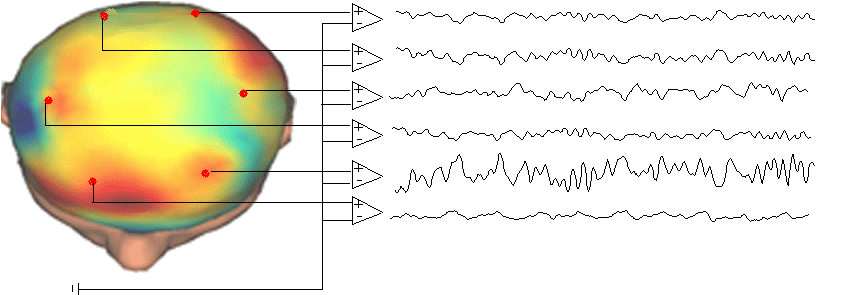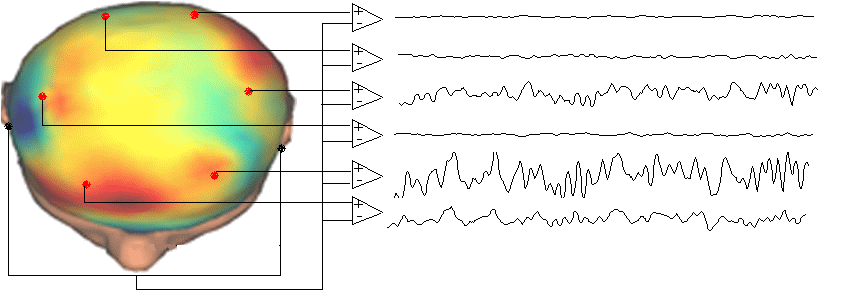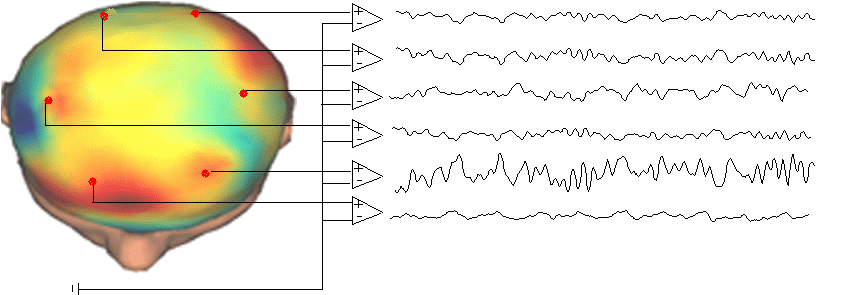Previous Guidelines for EEG/ERPs reference
| 1. IFCN guidelines
|
2.Guideline for ERPs
“ When comparing waveforms.. to literature, it is essential to consider differences in the reference.” “…Recordings can be made using either referential montages or bipolar montages… However, they (bipolar) are often very difficult to interpret in ERP studies.” “It is often helpful when comparing waveforms with those in the literature that use another reference to plot the waveforms using both references.” |
3. Clinical EEG
P201:
|
Independent Comments on REST
◆1.Marzetti, L., Nolte, G., Perrucci, M.G., Romani, G.L., & Gratta, C.D. (2007). The use of standardized infinity reference in EEG coherency studies.Nueroimage,36,48-63.[Link]
◆2.Kayser, J., & Tenke, C.E. (2010). In search of the Rosetta Stone for scalp EEG: converging on reference-free techniques. Clin Neurophysiol, 121, 1973-1975.[Link]
◆3.Robert W. Thatcher (2012): Coherence, Phase Differences, Phase Shift, and Phase Lock in EEG/ERP Analyses.Developmental Neuropsychology, 37:6, 476-496.[Link]
◆4.Liu Q, Balsters J H, Baechinger M, van der Groen O,Wenderoth N and Mantini D. Estimating a neutral reference for electroencephalographic recordings: the importance of using a high-density montage and a realistic head model J. Neural Eng. 12056012,2015.[Link]
◆5.Federico Chella, Vittorio Pizzella, Filippo Zappasodi, and Laura Marzetti. Impact of the reference choice on scalp EEG connectivity estimation. J. Neural Eng. 13 036016,2016.[Link]
Free Software
REST Main Features:
◆Graphic user interfaces
◆Multiformat data importing
◆Semi-automated artifact removal(bad channel)
Configuration Setup:
◆Windows Xp,Vista,7,8,10; ROM >=512M.
◆Recommended Resolution:1400*900 or higher.
REST Resources:
◆Download Rest Software(for free):
EXE Version (Updated Sep.22,2015) MatlabVersion_REST_v1.2_20190818
EEGLABPluginVersion-REST_v1.2_20200818 BP analyzer Plugin
◆Download User Manual of REST:
English Version Chinese Version
◆Download Talks document by Yao:
Scalp EEG/ERP with Zero Reference (Updated Sept. 15,2013)
2016零参考与认知脑电(中国认知科学学会第二届认知及转化医学大会报告)
◆Download Demonstration of REST:
Demonstration of REST (Chinese)
% -----------------------------------------------------------------------------------------------------------------
############################Please cite the toolbox as:>############################
Li Dong*, Fali Li, Qiang Liu, Xin Wen, Yongxiu Lai, Peng Xu and Dezhong Yao*. MATLAB Toolboxes for Reference Electrode Standardization Technique (REST) of Scalp EEG. Frontiers in Neuroscience, 2017:11(601).
% -----------------------------------------------------------------------------------------------------------------.
Caution:REST is a toolbox for humain EEG study only with no guarantee of suitability for any specific purpose. REST should not under any situations be used for clinic.
Privacy:We will not distribute email addresses to anyone for any purpose other than personal correspondance or message distribution.
Why REST
What is the best EEG reference?[YouTube]
As an electric phenomenon, the desired reference of EEG/ERP is zero at infinity. The human EEG was first published in 1929, and since then the reference issue has been a long-term debate as only the potential difference between two points can be measured, it is indispensable to have a reference point somewhere for scalp potential recording, however, there is no point on the scalp or body surface where the potential is zero or a constant. The ever-present experienced cephalic reference electrodes include the uni-mastoid or ear, linked mastoids or ears, the vertex, the tip of the nose, neck ring, average reference, etc. They have been utilized by different research groups in the world. However, all these references may introduce an undesired temporal bias to the EEG recordings because no one of them are neutral, and the nonzero reference signal itself may contain a physiological dynamic process that will be inevitably embedded into the other EEG recordings.
In the past 90 years since 1929, two strategies are time-tested:1) to find a less active point on the scalp or body surface as the reference, 2) to find a signal estimation method to recover the reference signal from the recordings. Unfortunately, these two ways are impractical because there is no point on the scalp or body surface where the potential is zero,and there is no distinct difference between the signal at a reference point from the other signals of the other electrodes. REST shot on the crucial fact of reference problem that reference issue is not a signal problem outside the head, but an electric field problem in the head, it is due to the electric field or electric current of a source in the brain reaching both reference electrode point and the all other electrodes,they are similar temporally that they cannot be discriminated by various blind signal decomposition methods in general. Actually, we are not blind, we know the neurophysics. It is better for the doer to undo what he has done (in Chinese, 解铃还须系铃人), and that is REST. REST is based on the fact that the underlying neural sources are the same no matter what a reference is actually adopted. So it tries to find the underlying sources first, or equivalently to recover the equivalent distributed source on the cortical surface, and then mathematically forward the neural sources to the scalp surface potential with a new reference at Infinity. The effectiveness has been evaluated for various cases (see the following references). The crucial merit is its ability to recover the true waveform and so to get correct estimate of various EEG/ERP features related to waveform, such as spectra analysis, waveform analysis (amplitude, latency, area etc), coherence/correlation, EEG network analysis, symmetry and asymmetry analysis, covariance and related statistic test.
As REST is a standardized procedure, EEG estimates based on such data would facilitate the comparison of results obtained from various laboratories.
About REST
What is REST?
REST (Reference Electrode Standardization Technique) is a re-reference technique, a software method for translating multichannel spontaneous EEG or event-related potentials with reference at any a physical point on brain/body surface or the post-processed data referenced at average or linked ears etc to a new dataset with reference at Infinity where the potential is zero/constant. REST appeared first in 2001(Yao, 2001), the first free download software was released in 2010, and followed a few updating version including EEGlab version. REST is now acknowledged more and more in EEG/ERPs community around the world, more than 50 stuides have actually adopted REST to get zero reference as the foundation of their following analyses.

Figure 1.Simulated EEG recordings with reference at infinity (zero)

Figure 2.Simulated EEG recordings with linked ears as reference. (RE= 47.33%)

Figure 3.Recovered EEG recorfings by REST with reference at infinity (RE= 0.073%)
Original REST literatures:
◆D.Yao. A method to standardize a reference of scalp EEG recordings to a point at infinity. Physiol. Meas., 22(4),693-711,2001.[Link]
◆Y.Zhai, D.Yao. A study on the reference electrode standardization technique for a realistic head model. Comput. Meth. Programs,76,229-238,2004[Link]Recent important evaluation studies:
◆L Marzetti, G Nolte, MG Perrucci, et al. The use of standardized infinity reference in EEG coherency studies. NeuroImage,36(1), 48-63, 2007.[Link]
◆Qin Y, Xu P and Yao D. A comparative study of different references for EEG default mode network: the use of the infinity reference Clin. Neurophysiol. 121 1981–91,2010.[Link]
◆Liu Q, Balsters J H, Baechinger M, van der Groen O,Wenderoth N and Mantini D. Estimating a neutral reference for electroencephalographic recordings: the importance of using a high-density montage and a realistic head model J. Neural Eng. 12056012,2015.[Link]
◆Federico Chella, Vittorio Pizzella, Filippo Zappasodi, and Laura Marzetti. Impact of the reference choice on scalp EEG connectivity estimation. J. Neural Eng. 13 036016,2016.[Link]
Electricity theory behind REST
1.Equivalent Source Theory in Electromagnetism(Huygens' Principle)
◆D Yao. Study of complex huygens' principle. International journal of infrared and millimeter waves 16 (4), 831-838, 1995.[Link]
◆D Yao. Complex source representation of time harmonic radiation from a plane aperture. IEEE Transactions on Antennas and Propagation, 43 (7), 720-723, 1995.[Link]
2. Equivalent Source Theory for EEG
◆D.Yao.Electric potential produced by a dipole in a homogeneous conducting sphere. IEEE Trans BME, 47(7), 964-966, 2000.[Link]
◆D. Yao. High-resolution EEG mappings: a spherical harmonic spectra theory and simulation results. Clinical Neurophysiology 111 (1), 81-92, 2000.[Link]
◆D. Yao. Source potential mapping: a new modality to image neural electric activities. Physics in medicine and biology 46 (12), 3177,2001.[Link]
◆D Yao, Y Zhou, M Zeng, S Fan, J Lian, D Wu, X Ao, L Chen, B He. A study of equivalent source techniques for high-resolution EEG imaging. Physics in medicine and biology 46 (8), 2255, 2001.[Link]
◆D. Yao. High-resolution EEG mapping: an equivalent charge-layer approach. Physics in medicine and biology 48 (13), 1997-2011,2003.[Link]
◆D.Yao, B.He. Equivalent physical models and formulation of equivalent source layer in high-resolution EEG imaging.Phys. Med. Biol.,48, 3475-3483,2003.[Link]
◆D Yao, ZK Yin, XH Tang, L Arendt-Nielsen, ACN Chen.High-resolution electroencephalogram (EEG) mapping: scalp charge layer. Physics in medicine and biology 49 (22), 5073-5086,2004.[Link]
Problem of Average Reference
Is the Surface Potential Integral of a Dipole in a Volume Conductor Always Zero?
◆D Yao. Is the Surface Potential Integral of a Dipole in a Volume Conductor Always Zero? A Cloud Over the Average Reference of EEG and ERP. 30 (2), 161–171, 2017.[Link] [PDF]